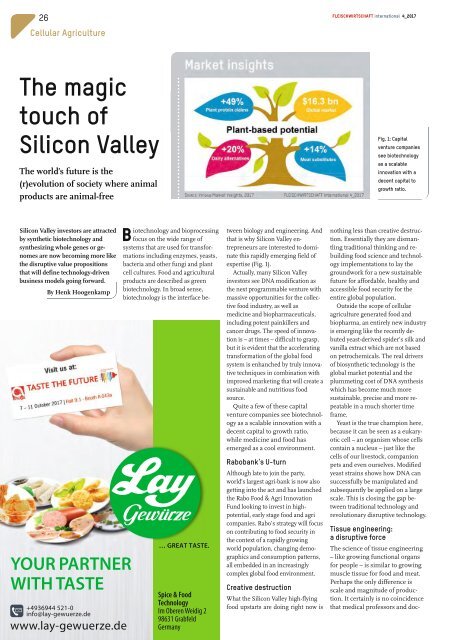FLEISCHWIRTSCHAFT international 4/2017
- No tags were found...
You also want an ePaper? Increase the reach of your titles
YUMPU automatically turns print PDFs into web optimized ePapers that Google loves.
.....................................<br />
26<br />
Fleischwirtschaft <strong>international</strong> 4_<strong>2017</strong><br />
Cellular Agriculture<br />
The magic<br />
touch of<br />
Silicon Valley<br />
The world’s future is the<br />
(r)evolution of society where animal<br />
products are animal-free<br />
Source: <strong>FLEISCHWIRTSCHAFT</strong><br />
<strong>international</strong> 4_<strong>2017</strong><br />
Fig. 1: Capital<br />
venture companies<br />
see biotechnology<br />
as ascalable<br />
innovation with a<br />
decent capital to<br />
growth ratio.<br />
Silicon Valley investors are attracted<br />
by synthetic biotechnology and<br />
synthesizing whole genes or genomes<br />
are now becoming more like<br />
the disruptive value propositions<br />
that will define technology-driven<br />
business models going forward.<br />
By Henk Hoogenkamp<br />
B<br />
iotechnology and bioprocessing<br />
focus on the wide range of<br />
systems that are used for transformations<br />
including enzymes, yeasts,<br />
bacteria and other fungi and plant<br />
cell cultures. Food and agricultural<br />
products are described as green<br />
biotechnology.Inbroad sense,<br />
biotechnology is the interface be-<br />
tween biology and engineering. And<br />
that is why Silicon Valley entrepreneurs<br />
are interested to dominate<br />
this rapidly emerging field of<br />
expertise (Fig. 1).<br />
Actually,many Silicon Valley<br />
investors see DNA modification as<br />
the next programmable venture with<br />
massive opportunities for the collective<br />
food industry,aswell as<br />
medicine and biopharmaceuticals,<br />
including potent painkillers and<br />
cancer drugs. The speed of innovation<br />
is –attimes –difficult to grasp,<br />
but it is evident that the accelerating<br />
transformation of the global food<br />
system is enhanched by truly innovative<br />
techniques in combination with<br />
improved marketing that will create a<br />
sustainable and nutritious food<br />
source.<br />
Quite afew of these capital<br />
venture companies see biotechnology<br />
as ascalable innovation with a<br />
decent capital to growth ratio,<br />
while medicine and food has<br />
emerged as acool environment.<br />
Rabobank’sU-turn<br />
Although late to join the party,<br />
world’s largest agri-bank is now also<br />
getting into the act and has launched<br />
the Rabo Food &Agri Innovation<br />
Fund looking to invest in highpotential,<br />
early stage food and agri<br />
companies. Rabo’s strategy will focus<br />
on contributing to food security in<br />
the context of arapidly growing<br />
world population, changing demographics<br />
and consumption patterns,<br />
all embedded in an increasingly<br />
complex global food environment.<br />
Creative destruction<br />
What the Silicon Valley high-flying<br />
food upstarts are doing right now is<br />
nothing less than creative destruction.<br />
Essentially they are dismantling<br />
traditional thinking and rebuilding<br />
food science and technology<br />
implementations to lay the<br />
groundwork for anew sustainable<br />
future for affordable, healthy and<br />
accessible food security for the<br />
entire global population.<br />
Outside the scope of cellular<br />
agriculture generated food and<br />
biopharma, an entirely new industry<br />
is emerging like the recently debuted<br />
yeast-derived spider’s silk and<br />
vanilla extract which are not based<br />
on petrochemicals. The real drivers<br />
of biosynthetic technology is the<br />
global market potential and the<br />
plummeting cost of DNA synthesis<br />
which has become much more<br />
sustainable, precise and more repeatable<br />
in amuch shorter time<br />
frame.<br />
Yeast is the true champion here,<br />
because it can be seen as aeukaryotic<br />
cell –anorganism whose cells<br />
contain anucleus –just like the<br />
cells of our livestock, companion<br />
pets and even ourselves. Modified<br />
yeast strains shows how DNA can<br />
successfully be manipulated and<br />
subsequently be applied on alarge<br />
scale. This is closing the gap between<br />
traditional technology and<br />
revolutionary disruptive technology.<br />
Tissue engineering:<br />
adisruptive force<br />
The science of tissue engineering<br />
–like growing functional organs<br />
for people –issimilar to growing<br />
muscle tissue for food and meat.<br />
Perhaps the only difference is<br />
scale and magnitude of production.<br />
It certainly is no coincidence<br />
that medical professors and doc-

















